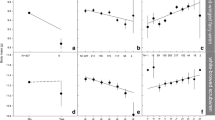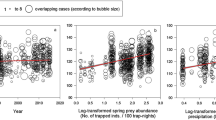Abstract
Animal populations are exposed to large-scale anthropogenic impact from e.g. climate change, habitat alteration and supplemental stocking. All of these may affect body condition in wintering dabbling ducks, which in turn may affect an individual’s survival and reproductive success. The aim of this study was to assess whether there have been morphometric changes in Mallard (Anas platyrhynchos) and Teal (Anas crecca) over the last 30 years at a major wintering site. Body mass and condition increased from the 1950s–1960s to the 2000s in both species. The increase in body mass amounted to as much as 11.7%, with no corresponding change in body size. Improved body condition was maintained from early to mid-winter, but then converged with historical values for late winter. Our interpretation is that increasingly benign ambient winter conditions permit ducks to maintain better energetic “safety margins” throughout winter, and that converging spring departure values may be related to evolutionary flight energetic optima. The observed changes are consistent with large-scale climate amelioration and local/regional habitat improvement (both anthropogenic).




Similar content being viewed by others
References
Baldassarre, G.A., and E.G. Bolen. 2006. Waterfowl ecology and management, 2nd ed, 580. New York: Wiley & Sons.
Baldassarre, G.A., R.J. Whyte, and E.G. Bolen. 1986. Body weight and carcass composition of nonbreeding Green-winged Teal on the Southern High Plains of Texas. Journal of Wildlife Management 50: 420–426.
Black, J.M., C. Deerenberg, and M. Owen. 1991. Foraging behaviour and site selection of Barnacle Geese Branta leucopsis in a traditional and newly colonised spring staging habitat. Ardea 79: 349–358.
Bub, H. 1991. Bird trapping and bird banding. A handbook for trapping methods all over the world, 330. New York: Cornell University Press.
Guillemain, M., H. Fritz, N. Guillon, and G. Simon. 2002. Ecomorphology and coexistence in dabbling ducks: The role of lamellar density and body length in winter. Oikos 98: 547–551.
Guillemain, M., H. Fritz, A.R. Johnson, and G. Simon. 2007. What type of lean ducks do hunters kill? Weakest local ones rather than migrants. Wildlife Biology 13: 102–107.
Guillemain, M., J.Y. Mondain-Monval, A.R. Johnson, and G. Simon. 2005a. Long-term climatic trend and body size variation in Teal Anas crecca. Wildlife Biology 11: 81–88.
Guillemain, M., O. Dehorter, A.R. Johnson, and G. Simon. 2005b. A test of the wintering strategy hypothesis with teal (Anas crecca) ringed in the Camargue, southern France. Journal of Ornithology 146: 184–187.
Hatzofe, O., and Y. Yom-Tov. 2002. Global warming and recent changes is Israel’s avifauna. Israel Journal of Zoology 48: 351–357.
Hirschfeld, A., and A. Heyd. 2005. Mortality of migratory birds caused by hunting in Europe: Bag statistics and proposals for the conservation of birds and animal welfare. Berichte zum Vogelschutz 42: 47–74.
Hughes, L. 2000. Biological consequences of global warming: Is the signal already apparent? TREE 15: 56–61.
Julliard, R., F. Jiguet, and D. Couvet. 2003. Common birds facing global changes: What makes a species at risk? Global Change Biology 10: 148–154.
Kaňuščák, P., M. Hromada, P. Tryjanowski, and T. Sparks. 2004. Does climate at different scales influence the phenology and phenotype of the River Warbler Locustella fluviatilis ? Oecologia 141: 158–163.
Laikre, L., A. Palmé, M. Josefsson, F. Utter, and N. Ryman. 2006. Release of alien populations in Sweden. Ambio 35: 255–261.
Latorre-Margalef, N., G. Gunnarsson, V.J. Munster, R.A.M. Fouchier, A.D.M.E. Osterhaus, J. Elmberg, B. Olsen, A. Wallensten, P.D. Haemig, T. Fransson, L. Brudin, and J. Waldenström. 2009. Effects of inluenza A virus infection on wild migratory Mallard ducks. Proceedings of the Royal Society of London, Series B 276: 1029–1036.
Lebreton, J.D. 1973. Etude des déplacements saisonniers des Sarcelles d’hiver, Anas c. crecca L., hivernant en Camargue à l’aide de l’analyse factorielle des correspondances. Comptes Rendus de l’Académie des Sciences, Paris 277: 2417–2420.
Legagneux, P. 2007. Compromis entre alimentation et risque de prédation chez les canards hivernants: une approche multi-échelles. PhD thesis, Université Louis Pasteur, Strasbourg, France.
Lindström, Å., and T. Alerstam. 1992. Optimal fat loads in migrating birds: A test of the time-minimization hypothesis. American Naturalist 140: 477–491.
Madsen, J., and S.P.P. Clausen. 1998. Establishing a reserve network for waterfowl in Denmark: A biological evaluation of needs and consequences. Biological Conservation 85: 241–255.
Mathevet, R. 2004. Camargue incertaine—Sciences, usages et natures, 201. Paris: Buchet-Chastel.
McCarthy, J.P. 2001. Ecological consequences of recent climate change. Conservation Biology 15: 320–331.
Millien, V., S.K. Lyons, L. Olson, F.A. Smith, A.B. Wilson, and Y. Yom-Tov. 2006. Ecotypic variation in the context of global climate change: Revisiting the rules. Ecology Letters 9: 853–869.
Mondain-Monval, J.Y. and Girard, O. 2000. Le Canard Colvert, la Sarcelle d’Hiver & autres canards de surface. In Enquête Nationale sur les Tableaux de chasse à tir saison 1998–1999, ed. Landry, P. and P. Migot, 124–139. Faune Sauvage 251.
Pirot, J.Y., D. Chessel, and A. Tamisier. 1984. Exploitation alimentaire des zones humides de Camargue par cinq espèces de canards de surface en hivernage et en transit: Modélisation spatio-temporelle. Revue d’ Ecologie (Terre Vie) 39: 167–192.
Prop, J., J.M. Black, P. Shimmings, and M. Owen. 1998. The spring range of barnacle geese Branta leucopsis in relation to changes in land management and climate. Biological Conservation 86: 339–346.
Ridgill, S.C., and A.D. Fox. 1990. Cold weather movements of waterfowl in Western Europe, 89. IWRB Special Publication 13. Slimbridge: IWRB.
Smith, F.A., H. Browning, and U.L. Sheperd. 1998. The influence of climate change on the body mass of woodrats Neotoma in an arid region of New Mexico, USA. Ecography 21: 140–148.
Smith, D.B., and F.C. Rohwer. 1997. Perceptions of releases of captive-reared Mallards, with emphasis on an intensive program in Maryland. Transactions of the North American Wildlife and Natural Resources Conference 62: 403–411.
Tamisier, A., and P. Grillas. 1994. A review of habitat changes in the Camargue: An assessment of the direct effects of the loss of biological diversity on the wintering waterfowl community. Biological Conservation 70: 39–47.
Tamisier, A., and O. Dehorter. 1999. Camargue, canards et foulques—Fonctionnement et devenir d’un prestigieux quartier d’hiver, 369. Nîmes: Centre Ornithologique du Gard
Tamisier, A., and P. Isenmann. 2004. Milieux et paysages de Camargue. Description, status fonciers et statuts de protection, changements quantitatifs et qualitatifs, pollution. In Les oiseaux de Camargue et leurs habitats. Une histoire de cinquante ans 1954–2004, ed. P. Isenmann, 21–53. Paris: Buchet Chastel.
Tamisier, A., L. Allouche, F. Aubry, and O. Dehorter. 1995. Wintering strategies and breeding success: Hypothesis for a trade-off in some waterfowl species. Wildfowl 46: 76–88.
Thomas, C.D., and J.J. Lennon. 1999. Birds extend their ranges northwards. Nature 399: 213.
Thorup, K., A.P. Tøttrup, and C. Rahbek. 2007. Patterns of phenological changes in migratory birds. Oecologia 151: 697–703.
U.S. Fish and Wildlife Service. 2003. Review of captive-reared Mallard regulations on shooting preserves, Final draft, 50. Washington: Division of Migratory Bird Management, US Fish and Wildlife Service.
Walther, G.R., E. Post, P. Convey, A. Menzel, C. Parmesan, T.J.C. Beebee, J.M. Fromentin, O. Hoegh-Guldberg, and F. Bairlein. 2002. Ecological responses to recent climate change. Nature 416: 389–395.
Yom-Tov, Y. 2001. Global warming and body mass decline in Israeli passerine birds. Proceedings of the Royal Society of London. Series B 268: 947–952.
Yom-Tov, Y. 2003. Body sizes of carnivores commensal with humans have increased over the past 50 years. Functional Ecology 17: 323–327.
Yom-Tov, Y., and S. Yom-Tov. 2004. Climatic changes and body size in two species of Japanese rodents. Biological Journal of the Linnean Society 82: 263–267.
Yom-Tov, Y., and S. Yom-Tov. 2005. Global warming, Bergmann’s rule and body size in the masked shrew Sorex cinereus Kerr in Alaska. Journal of Animal Ecology 74: 803–808.
Yom-Tov, Y., S. Yom-Tov, and G. Jarrell. 2008. Recent increase in body size of the American marten Martes Americana in Alaska. Biological Journal of the Linnean Society 93: 701–707.
Yom-Tov, Y., S. Yom-Tov, J. Wright, C.J.R. Thorne, and R. Du Feu. 2006a. Recent changes in body weight and wing length among some British passerine birds. Oikos 112: 91–101.
Yom-Tov, Y., T.M. Heggberget, Ø. Wiig, and S. Yom-Tov. 2006b. Body size changes among otters, Lutra lutra, in Norway: The possible effects of food availability and global warming. Oecologia 150: 155–160.
Acknowledgements
We are grateful to Raphaël Mathevet and Jean-Baptiste Mouronval for useful advice concerning habitat use and management practices in the Camargue. We are most grateful to Luc Hoffmann, Hubert Kowalski, Heinz Hafner, Alan Johnson, and the other people who ringed Teal at Tour du Valat for over 25 years. We would especially like to thank Marc Lutz, Paul Isenmann, and the Centre de Recherche sur la Biologie des Populations d’Oiseaux (Muséum National d’Histoire Naturelle, Paris) for their help while computerizing the French Teal database. Grant V-162-05 from the Swedish Environmental Protection Agency supported the study. Jocelyn Champagnon was supported by a Doctoral Grant from ONCFS and further support from CNRS and Tour du Valat.
Author information
Authors and Affiliations
Corresponding author
Rights and permissions
About this article
Cite this article
Guillemain, M., Elmberg, J., Gauthier-Clerc, M. et al. Wintering French Mallard and Teal Are Heavier and in Better Body Condition than 30 Years Ago: Effects of a Changing Environment?. AMBIO 39, 170–180 (2010). https://doi.org/10.1007/s13280-010-0020-9
Received:
Revised:
Accepted:
Published:
Issue Date:
DOI: https://doi.org/10.1007/s13280-010-0020-9




